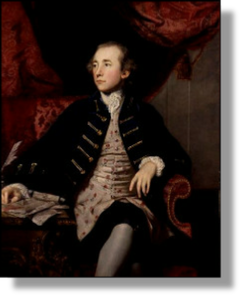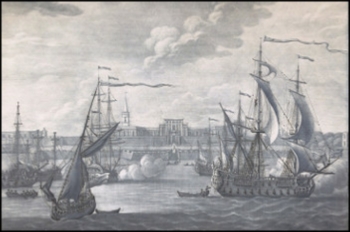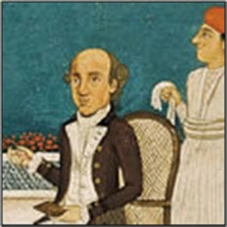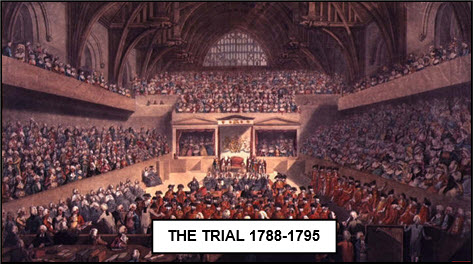


WARREN HASTINGS 1732 -
xxxxxThe English colonial administrator Warren Hastings spent his working life in the service of the East India Company, and is regarded as one of the principal founders of British India. He served as governor of Bengal from 1772 to 1774, and was then appointed the country's first governor general, resigning in 1785. In these offices he made substantial improvements in the administration of Bengal, establishing a system of government which was employed more widely as British rule expanded. As we shall see (1775), by his political as well as his military skill, he also preserved the company in two major conflicts, the first Anglo-
 xxxxxThe British statesman Warren Hastings spent his working life in the service of the East India Company and the government of India. He joined the company in 1750, and, apart from a break of four years, remained in India until 1785, retiring as the country's first governor general. He can rightly be regarded as one of the principal founders of British India. However, on returning to England, he was impeached on charges of corruption, and was not acquitted by the House of Lords until 1795, after a trial lasting seven years. (The portrait is by Joshua Reynolds.)
xxxxxThe British statesman Warren Hastings spent his working life in the service of the East India Company and the government of India. He joined the company in 1750, and, apart from a break of four years, remained in India until 1785, retiring as the country's first governor general. He can rightly be regarded as one of the principal founders of British India. However, on returning to England, he was impeached on charges of corruption, and was not acquitted by the House of Lords until 1795, after a trial lasting seven years. (The portrait is by Joshua Reynolds.)
xxxxxHastings was born in Churchill, Oxfordshire, the son of an Anglican clergyman. He was abandoned by his father as a small child, and brought up by an uncle. He attended Westminster School, London, and at the age of 17 went to Bengal as a junior clerk (known as a "writership") in the British East India Company. From the beginning of his service he showed an interest in the life and customs of the Indian people -
xxxxxHis first major appointment came in 1772, when he was made governor of Bengal. Since the departure of Robert Clive corruption had increased, and there was little effective government. Many company employees had amassed huge personal fortunes by plundering the wealth of Bengal and, indeed, the company itself. These so- r general. He was stationed at Calcutta (
r general. He was stationed at Calcutta (
xxxxxOn taking up his office, he was under strict instructions to avoid conflict and concentrate on consolidating British hold on Bengal as a centre for trade. However, given the chaotic situation of the country at that time -
 xxxxxBut success on the battlefield was not matched in the corridors of power. In the supreme council, Hastings was constantly in conflict with his four fellow members -
xxxxxBut success on the battlefield was not matched in the corridors of power. In the supreme council, Hastings was constantly in conflict with his four fellow members -
xxxxxThe following year Hastings resigned as governor-
 xxxxxThere is little doubt that certain actions on his part laid him wide open to criticism. He had, for example, demanded money with menaces from Raja Chait Singh of Varanasi, and he had forcibly taken over the treasures of the begums (queens) of Oudh. Hastings argued that such acts, highhanded though they might be, were necessary given the urgent need to raise funds to wage a series of costly wars. However, questions were also raised about the exact source of his own personal income, and there was, too, the case of the native Maharaga Nandakumar. He had openly accused Hastings of extortion and, as a result, some suggested, was conveniently found guilty of forgery and executed. This said, the accusations by Philip Francis had all the hallmarks of a vendetta. Furthermore, it could well be argued that the former governor-
xxxxxThere is little doubt that certain actions on his part laid him wide open to criticism. He had, for example, demanded money with menaces from Raja Chait Singh of Varanasi, and he had forcibly taken over the treasures of the begums (queens) of Oudh. Hastings argued that such acts, highhanded though they might be, were necessary given the urgent need to raise funds to wage a series of costly wars. However, questions were also raised about the exact source of his own personal income, and there was, too, the case of the native Maharaga Nandakumar. He had openly accused Hastings of extortion and, as a result, some suggested, was conveniently found guilty of forgery and executed. This said, the accusations by Philip Francis had all the hallmarks of a vendetta. Furthermore, it could well be argued that the former governor-
xxxxxImpeachment aside, Hastings, as governor of Bengal, overhauled the administration of this province and introduced a machinery of government which was to be adopted by Britain as -
xxxxxIncidentally, from the earliest days of English parliamentary history, the House of Lords had exclusive right to impeach public officials, based on public outcry. It was not until the Good Parliament of 1376 that the House of Commons began to initiate impeachment proceedings, but even then the trial took place in the House of Lords. In modern times impeachment has rarely been invoked. ...…

xxxxx...... As we have seen, the politician Edmund Burke played a prominent part in the impeachment proceedings. His opening speech in February 1788, which attacked the East India Company's exploitation of the Indian people -
Acknowledgements
Hastings: by the English portrait painter Sir Joshua Reynolds (1723-
G3a-


